This lacto-fermented salsa is an easy way to preserve the harvest and include more probiotics to your diet. It's tangy and zesty and has a perfect spice kick to accompany your favorite Mexican meals or just to dig in with tortilla chips.
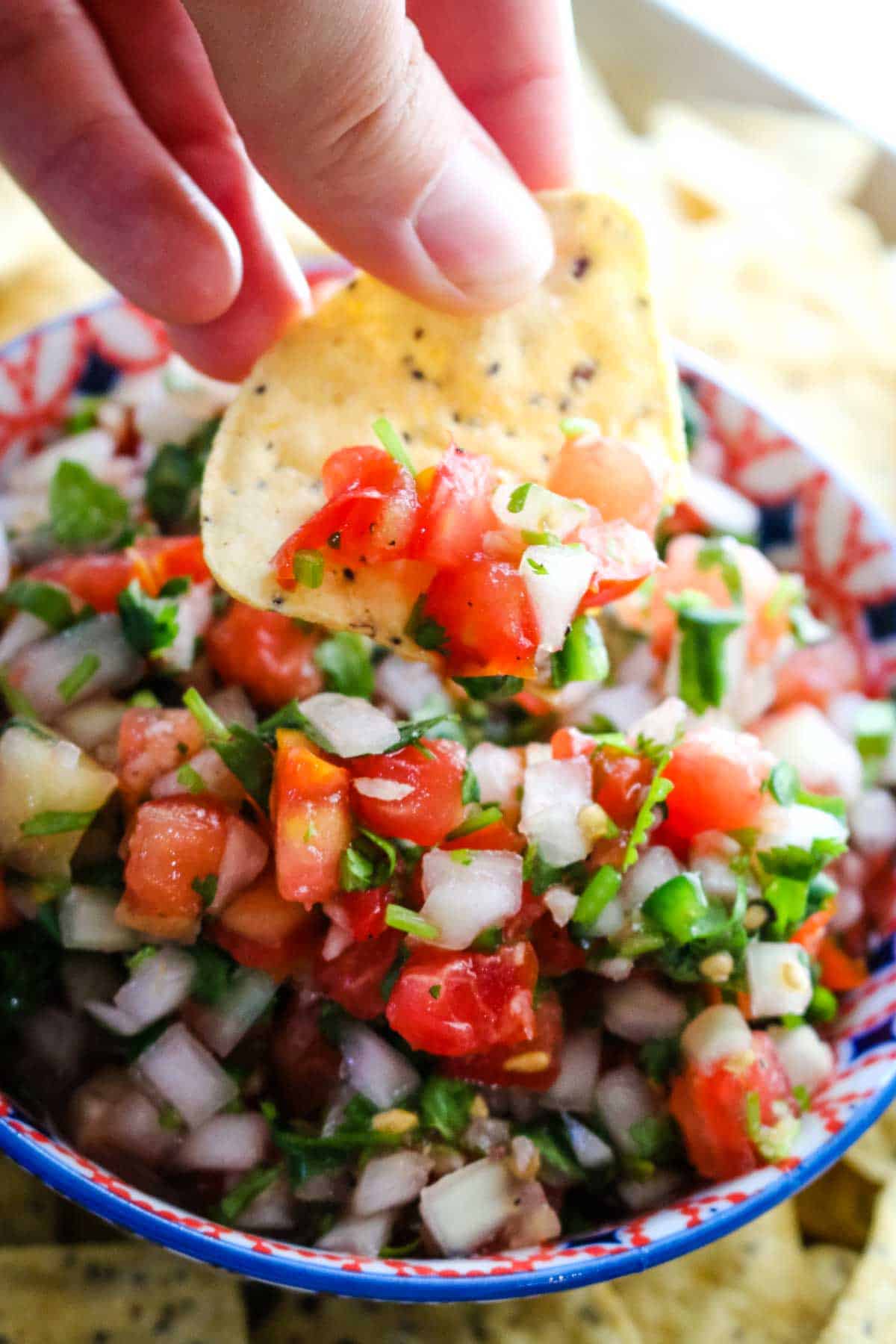
This easy recipe is an easy way to include natural probitiocs that is great for gut health.
When freshly prepared, this simple salsa is a basic pico de gallo but when left at room temperature for a few days, it will create good bacteria during this fermentation process that is great for gut health.
It is a perfect accompaniment to your favorite Mexican dish.
What is Fermented Salsa?
Lacto-fermentation is used to produce traditionally cultured dill pickles, kimchi, sauerkraut, and this salsa. It usually requires nothing more than adequate supply of real salt, vegetables, and water.
The beauty of lacto-fermentation is that no fancy equipment or canning supplies are needed. Just your ingredients and good quality salt.
Lacto-fermentation is a metabolic process by which glucose in the foods is converted into cellular energy and produces lactic acid. This process wipes out the bad bacteria in foods and the good bacteria which is tolerant to salt converts to lactic acid.
This lactic acid is a natural preservative that helps fight the bad bacteria and preserves the flavor and nutrient profile of these foods.
Different strains of this Lactobacillus bacteria have different strain-specific health benefits. That's why, as with all foods, it's important to get a variety of truly lacto-fermented foods in your diet.
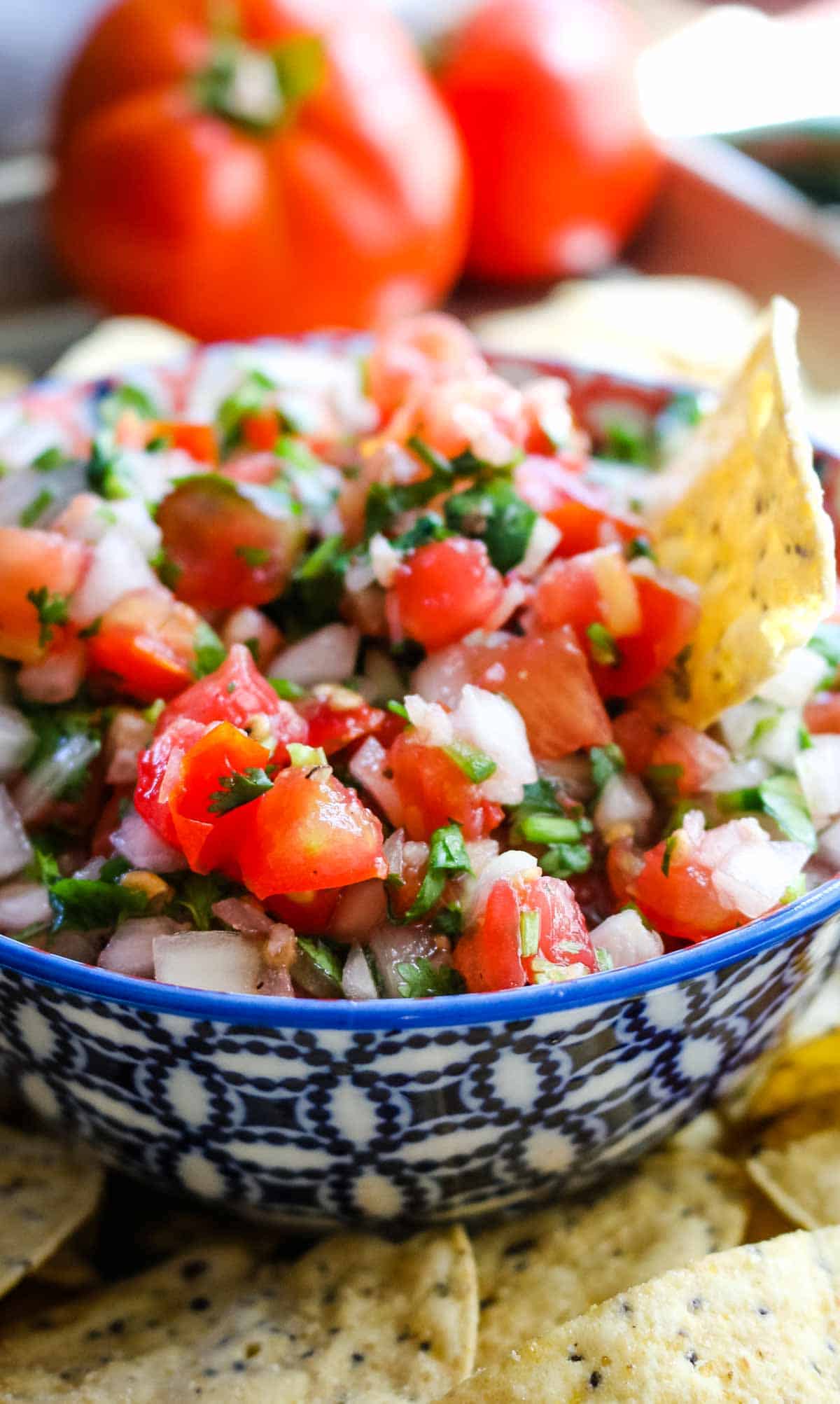
Preserving Fresh Tomatoes
Making this Lacto-Fermented Salsa is also a great way to preserve your tomato harvest.
For centuries, seasonal vegetables were only available fresh during their growing seasons. All the surplus was carefully fermented or cultured to last in cold storage during the leaner months.
This is done to extend shelf life. Properly cultured foods can last up to 6-8 months, well in time for the next bumper of crops.
In our modern world today, we are blessed to have fresh produce available to us year round, whether at the farmers market or the grocery store. And even though we have no need to preserve foods, the health benefits and nutrition of fermented foods still applies to us.
Good to Know: The process of lacto-fermentation produces good bacteria that has gut-healthy probiotics.
From Pico de Gallo to Fermented Salsa
The difference between tomato salsa pico de gallo and fermented salsa is the time spent at room temperature.
If you want fresh, zesty, tangy pico de gallo or regular salsa, follow the recipe below and transfer the homemade salsa straight to the refrigerator to stop or greatly hinder the fermentation process.
It will keep in the refrigerator for several weeks before it starts producing live cultures and natural bacteria that will eventually turn it into fermented salsa.
However, if you want the health benefits of fermented salsa quicker, you'll need to give it more time to sit at room temperature to allow that bacteria transformation.
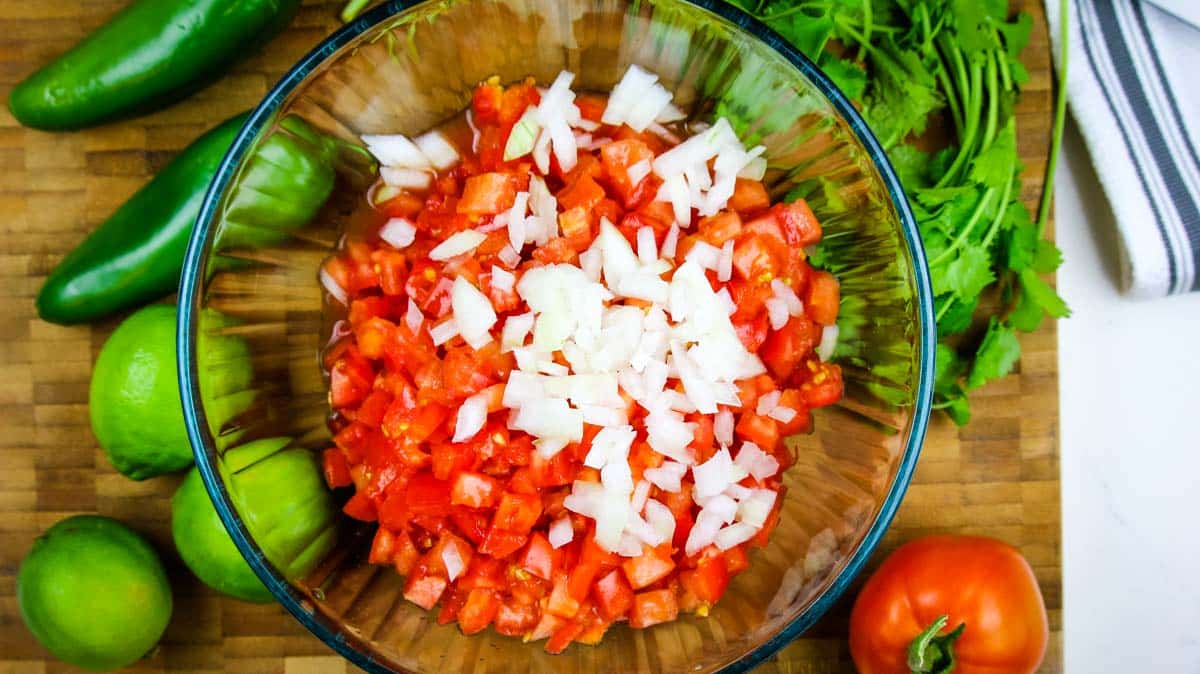
What are the ingredients in Fermented Salsa?
- Tomatoes: any tomatoes will work but the best are those fresh from your garden or farmer's market
- Onion: yellow, white, or red onion will work
- Hot pepper: jalapeno or serrano pepper is the best option here
- Fresh garlic: fresh is best - garlic powder won't cut it and neither will jarred
- Cilantro: this may be debatable, but salsa isn't salsa without cilantro
- Limes: this is also a must but you can sub lemons in a pinch
- Salt: this is what we will be using to culture or ferment the salsa so be sure it's good quality real salt, say no to iodized salt.
- Black Pepper: last but not least black pepper adds nice flavor
This is Lacto-Fermented Salsa recipe without whey, provided that you have adequate salt to create those good microbes.
Make it Nutrient-Dense: Because tomatoes are on the EWG's Dirty Dozen list, it's best to use organic tomatoes or better yet, grow them yourself to avoid pesticide residue.
Suggested Substitutions and Variations
This simple salsa recipe is pretty forgiving. Any garden fresh tomatoes and onions will work.
The only thing that is non-negotiable is the use of good quality, unrefined salt. I prefer fine (not coarse) Redmond's Real Salt (use code NOURISH for 10% off).
If you would like to read more about the importance of unrefined salt in your diet and which salt is best to use for specific dishes, check out this Unrefined Salt Guide post.
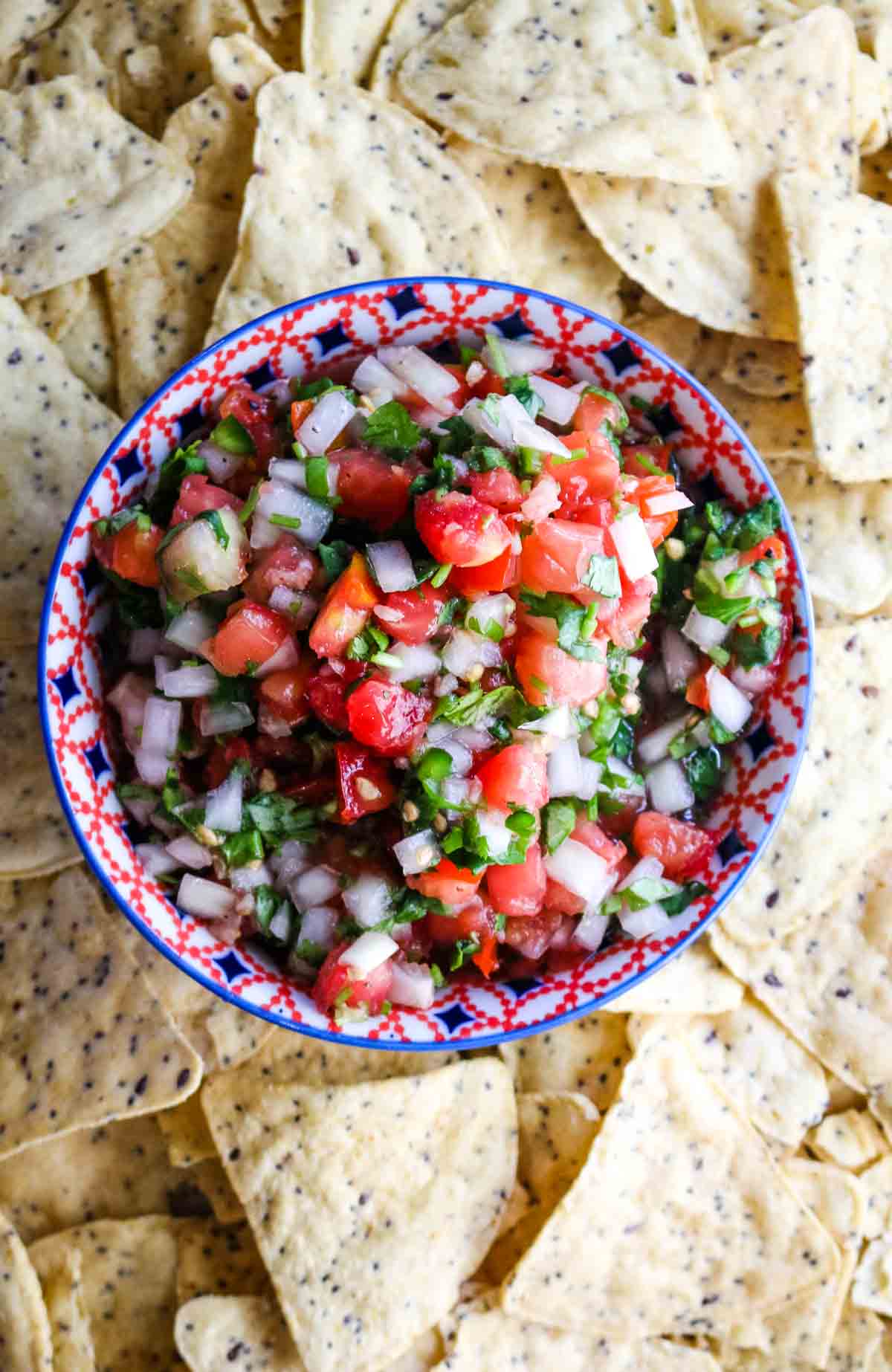
Frequently Asked Questions & Tips
When fermented properly, this salsa will last in dark, cold storage such as the refrigerator for up to 4 months. Look for any signs of mold and use your sense of smell to test for any foul odor. Even after 4 months, the salsa should not be mushy if prepared properly.
As with most things that are using the process of lacto-fermentation, you do want to create an environment where these natural gases can escape. This is done with a loose fitting lid or every 12 hours or so, opening it and releasing those gases. That would also be a good time to make sure that the salsa is fully submerged in what now should be a salty brine.
Your lacto-fermented foods are only as good as your salt. That is because truly unrefined real salt contains lots of minerals and enzymes needed for this fermentation process. I prefer using Redmond's real fine salt for best results.
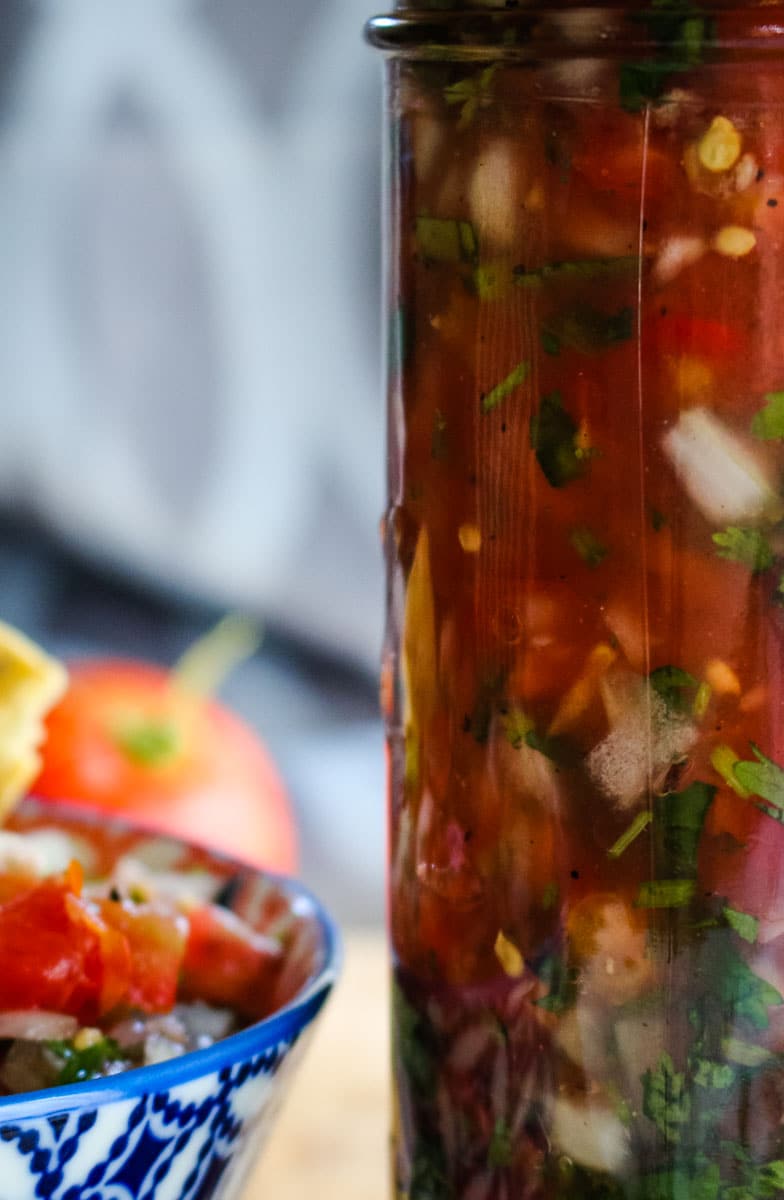
Storage Instructions
To store: After 2 days of allowing the salsa to naturally ferment at room temperature, transfer to back of the refrigerator and store there for up to 4 months.
Storage containers: My favorite vessels for lacto-fermented foods are wide-mouth Mason jars similar to these. They come in various sizes and are easy to access.
How to make Fermented Salsa
The complete printable recipe is below in the recipe card for your convenience.
This Lacto-Fermented Salsa recipe calls for these raw ingredients that you will need: fresh tomatoes, white onion, hot pepper like serrano or jalapeno pepper, raw garlic, fresh cilantro, limes, sea salt, and black pepper.
Step 1. Chop all raw vegetables
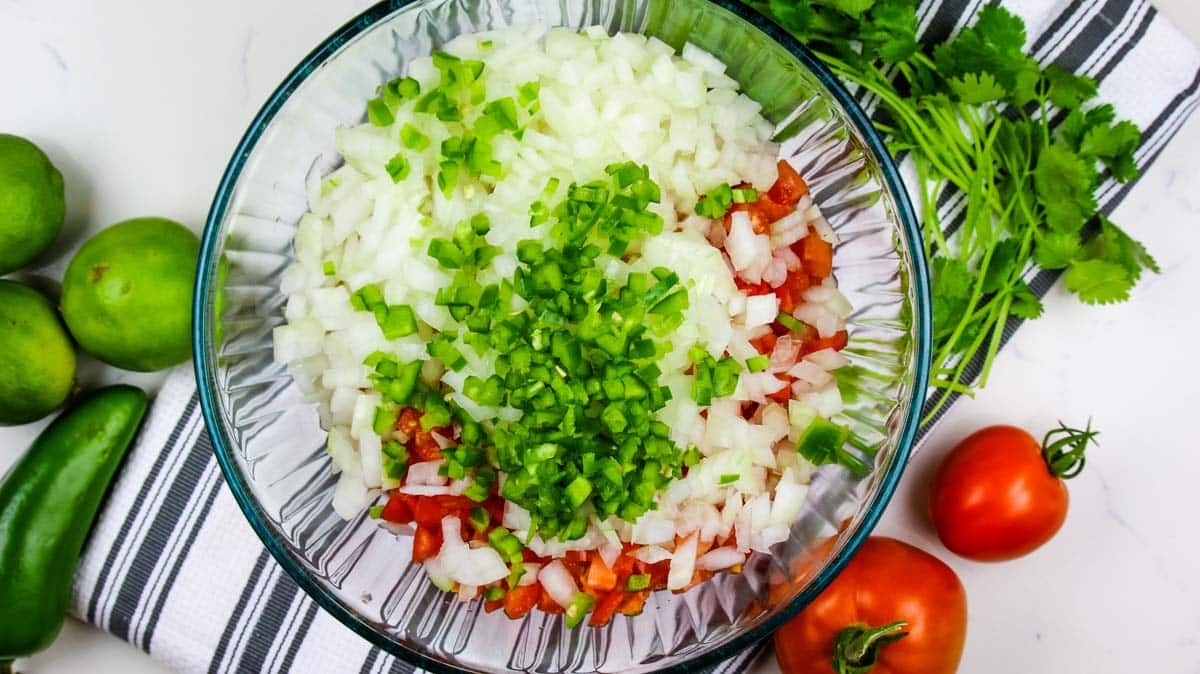
Finely dice the onion with sharp knife or a tool like this chopper (I use the smaller hole insert for onions and larger for tomatoes). Dice tomatoes in the same manner and transfer to a large bowl.
Seed and mince the hot pepper into small pieces according to personal taste. Add to tomatoes and onions.
Add finely chopped cilantro and minced garlic.
Did you know? Garlic contains an enzyme called allicin. For maximum health benefits, wait 10 minutes between mincing it and combing it for the enzyme to activate.
Step 2. Combine everything
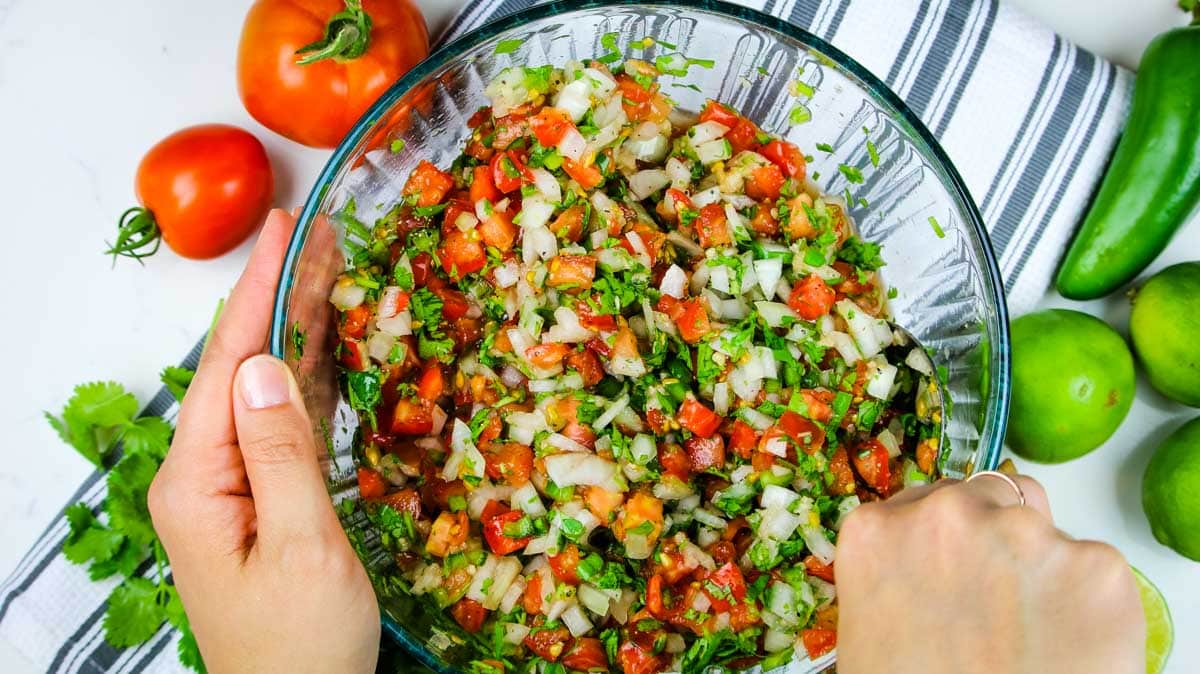
Squeeze the juice of limes (or lemons if no limes) and season with salt and pepper.
Toss to combine everything well.
At this point, this is your normal fresh salsa that is incredibly fresh-tasting and delicious. It has bright flavor and is great for picky eaters who don't particularly appreciate the fermented flavor.
Transfer the salsa into smaller jars and close the lid loosely.
To halt the fermentation process, transfer this salsa to the refrigerator and it will very slowly ferment in there. This can potentially add months to the shelf life.
Step 3: Set to ferment
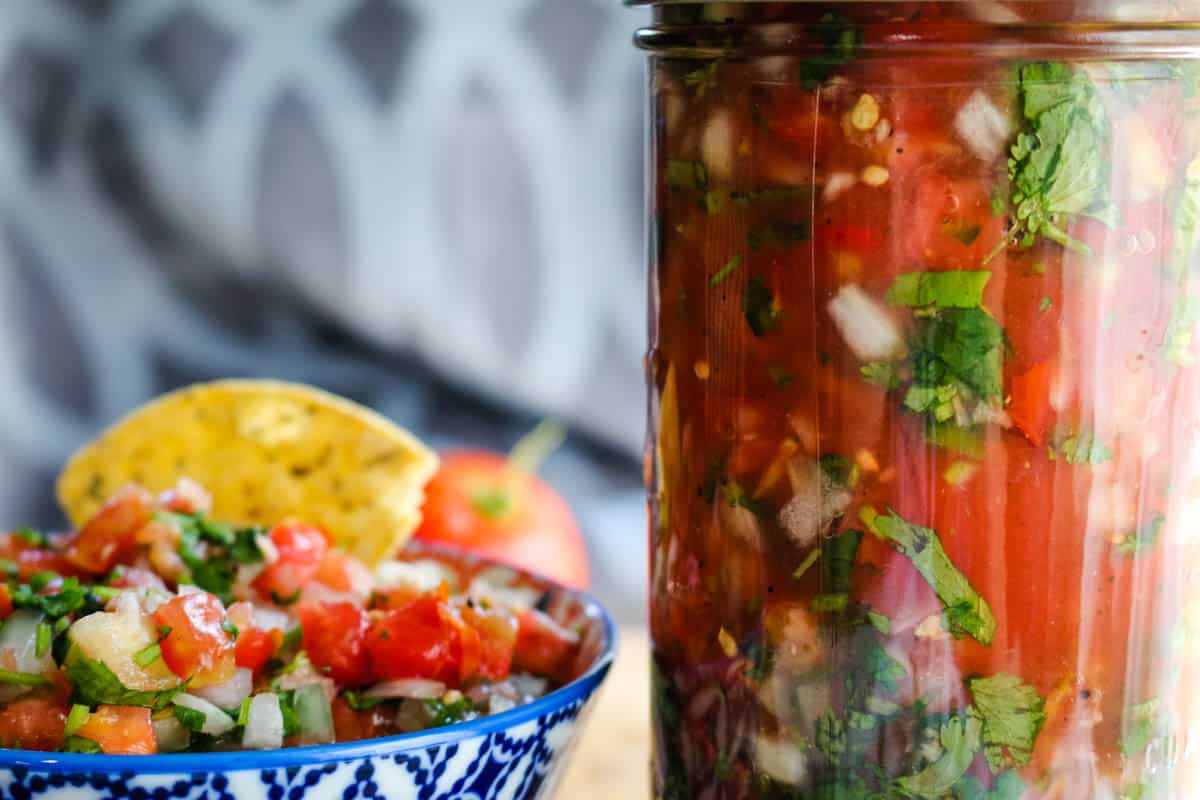
However, if you want the fermentating process to begin immediately, leave it at warmer temperatures but away from direct sunlight for couple of days (depending on your room temperature) until it starts forming that tangy flavor.
Keep the lid on very loosely to make sure natural gases have room to expand and escape. Make sure that the salsa is fully submerged in the salted brine as the tomatoes will start releasing much juice.
A fermentation glass weight like this one is an easy way to make sure all salsa is submerged.
Helpful Tip: Make sure the lid to the salsa jar isn't so tight so the naturally producing gasses can escape and that all the salsa is fully submerged in the brine.
Helpful Tools & Links
Below are some links that may be helpful to you as you make this recipe. You can find some of these items cheaper at your local store but it helps to have a link so you know what you're looking for.
- Tools: chef knife, cutting board, large mixing bowl, salad chopper, fermenting weight
- Ingredients: real salt, black pepper
- Storage Supplies: wide-mouth mason jars for leftovers, Weck preserving jars
What to eat with Lacto-Fermented Salsa
As with most lacto fermented foods, they are most enjoyed as a condiment in your daily diet for good health because of their good bacteria content.
Enjoy this salsa with these recipes:
- Homemade Sprouted Corn Tortilla Chips
- Sheet Pan Nachos
- Crispy Carnitas
- Pulled Pork Breakfast Skillet
- Acorn Squash Burrito Bowls
Looking for more lacto-fermented recipes? Here are some ideas:
- Lacto-Fermented Dill Pickles
- Okroshka Recipe (Russian Cold Soup)
- Lacto-Fermented Jalapeno Peppers
- Sauerkraut
Did you make this? Please leave a ⭐ recipe rating in the recipe card below and leave a review in the comments. Thank you!💚
Printable Recipe
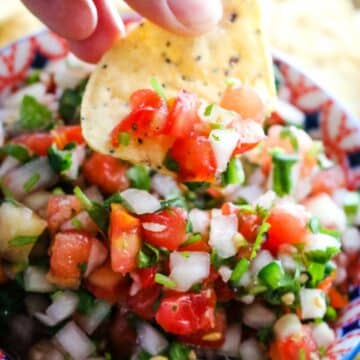
Fermented Tomato Salsa
Equipment
Ingredients
- 2 pounds fresh tomatoes
- 1 yellow onion
- 1 jalapeno or serrano pepper
- 6 garlic cloves
- 1 bunch of chopped cilantro
- juice of 2 limes
- 2 ½ teaspoon fine sea salt
- ½ teaspoon black pepper
Instructions
- Dice tomatoes into ¼" cubes. Finely dice onions. Transfer to large bowl.
- Seed and mince jalapeno or serrano pepper. Add to onions and tomatoes.
- Finely chop cilantro. Add minced garlic and juice of limes. Season with salt and pepper and combine everything.
Video
Notes
- Peppers: You can seed the hot peppers first for low-heat salsa but save them. After a taste test, you can add some of the seeds for additional heat if desired.
- If fresh pico de gallo is desired, transfer the salsa to the refrigerator without allowing to ferment at room temperature. It will taste fresh for up to 2 weeks, then will slowly start to culture and develop a tang.
- It is not necessary to add a culture or starter such as whey or sauerkraut juice. It will ferment with enough salt and time on its own. Make sure you use the full amount of salt.
- Fermented salsa can be kept in the refrigerator for up to 4 months.
Nutrition
The information shown is an estimate provided for your convenience by an online calculator. It should not be considered as a substitute for a professional nutritionist's advice. See our complete Nutritional Information Disclaimer.
©Prepare and Nourish • Content and photographs are copyright protected. Sharing of this recipe is encouraged and appreciated but please do NOT screenshot or copy/paste complete recipes to websites or social media.
This post was originally published April 2017 but has since been updated to include helpful information.


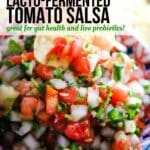

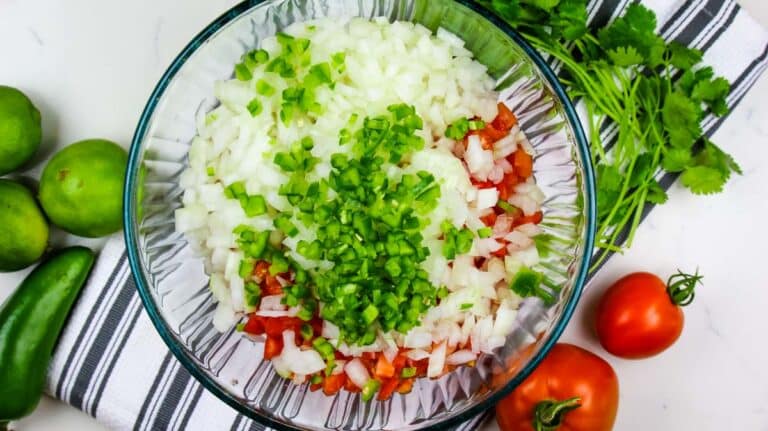
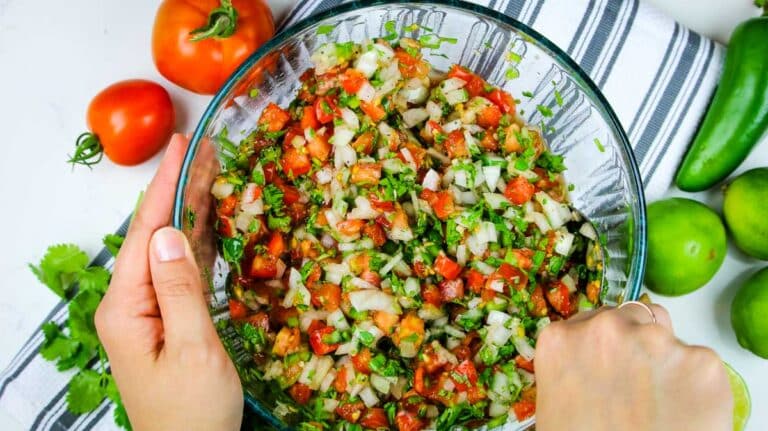

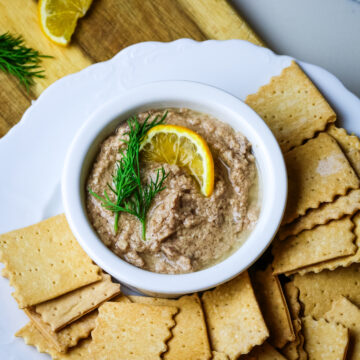
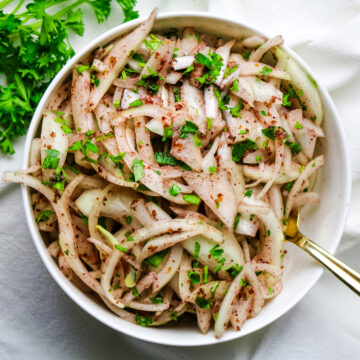
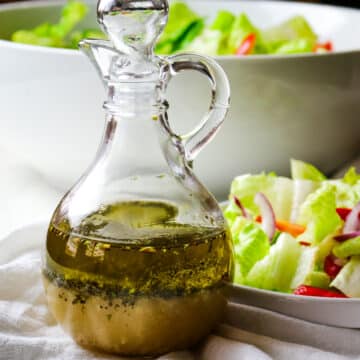
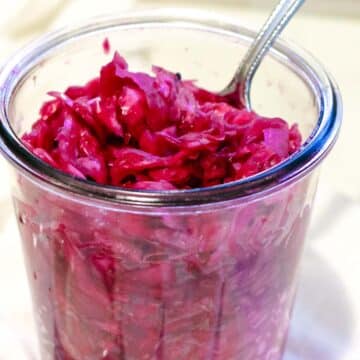
Emily @ Recipes to Nourish says
This is so awesome Anya! I've never made fermented salsa before, I didn't know it was so easy to do. Thank you for sharing your method.
Anya says
Hope you enjoy it Emily!
Holley Marth says
Fresh salsa is the best!
Anya says
Agreed!!
Rebecca says
Would it be safe to use canned tomatoes?
Anya says
Hi Rebecca,
I use canned tomatoes for my winter blender salsa (recipe here: https://prepareandnourish.com/winter-salsa-recipe-in-5-minutes/). I'm not sure how it well it would ferment though.
Billy says
This looks delicious! How does the flavor change based on how long you've kept it in the fridge? You mentioned it could last up to months, but is it still worth eating when you keep it that long? Is the flavor still enjoyable? Thank you for sharing!
Anya says
Thanks Billy. With more time, the salsa does take on more of a "ferementy" taste and smell. We still enjoy it and use it wherever we typically use salsa. But we have been eating ferments for many years so we're used to the cultured flavor. The onions aren't as crunchy of course but it's still a delicious salsa nonetheless.
Rocco says
Is there any fear in contracting botulism? since this can be kept for months... Or is the recipe naturally acidic enough that you dont have to worry about it.
Anya says
Hi Rocco,
I personally never had an issue with that - especially since the salsa is still kept in the refrigerator. But if you have any concerns, best to eat it sooner rather than later. 😉
Kristine says
Could I add a tablespoon of whey?
Anya says
No need for that. The salt will do its' magic.
Kelly @ A Girl Worth Saving says
Why did I think that making fermented salsa was going to be much harder? This is so simple, I'm going to grab some tomatoes from the farmers market and make this.
Wacey says
Perfect. So so good. Thanks for sharing !
Sarah Martin says
I love this recipe, but wanted to know how much salsa does it make when you make it? I'm using roma tomatoes so I just add until it tastes right, but not sure how much salt to add for proper fermentation.
Anya says
Hi Sarah,
This recipe would make approximately a quart, depending on the size of your tomatoes. I would probably use about 10 roma tomatoes since they are smaller than regular tomatoes. The salt amount per recipe should be sufficient for a quart of salsa. 🙂
Tammy says
This is our go to for our fermented Pico. Thank you. 5 stars all the way.